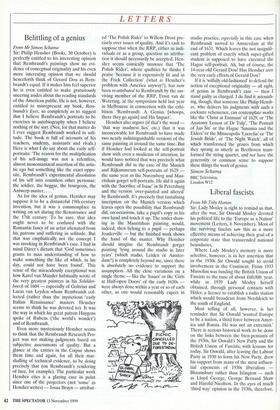LETTERS
Belittling of a genius
From Mr Simon Schama
Sir: Philip Hensher (Books, 30 October) is perfectly entitled to his interesting opinion that Rembrandt's paintings show no evi- dence of conceptual originality and his even more interesting opinion that we should henceforth think of Gerard Dou as Rem- brandt's equal. If it makes him feel superior he is even entitled to make gratuitously sneering asides about the reading standards of the American public. He is not, however, entitled to misrepresent my book, Rem- brandt's Eyes, so completely as to suggest that I believe Rembrandt's portraits to be exercises in autobiography when I believe nothing of the sort. (Nor, for that matter do I ever suggest Rembrandt worked in soli- tude. The book is full of accounts of his teachers, students, assistants and rivals.) Here is what I do say about the early self- portraits: The reason for the multiplication of his self-image was not a relentless, almost monomaniacal assertion of the artis- tic ego but something like the exact oppo- site, Rembrandt's experimental dissolution of his self into countless other personae: the soldier, the beggar, the bourgeois, the Antwerp master....'
As for the idea of genius, Hensher may suppose it to be a distasteful 19th-century invention, but it was a commonplace in writing on art during the Renaissance and the 17th century. To be sure, that idea ought never to be confused with the Romantic fancy of an artist alienated from his patrons and suffering in solitude. But that was emphatically not the concept I was invoking in Rembrandt's case. I had in mind Dfirer's dictum that 'God sometimes grants to man understanding of how to make something the like of which, in his day, could not have been found'. This sense of the miraculously exceptional was how Karel van Mander habitually wrote of the very greatest painters in his Schilder- boeck of 1604 — especially of Goltzius and Lucas van Leyden whom Rembrandt col- lected (rather than the mysterious 'early Italian Renaissance' masters Hensher seems to think he was devoted to). It was the way in which his great patron Huygens spoke of Rubens ('the world's wonder') and of Rembrandt.
Even more mysteriously Hensher seems to think that the Rembrandt Research Pro- ject was not making judgments based on subjective assessments of quality. But a glance at the entries in the Corpus shows them time and again, for all their mar- shalling of technical evidence, to be doing precisely that (on Rembrandt's rendering of lace, for example). The particular work Hensher cites is a glaring case in point since one of the projectors (not 'some' as Hensher writes) — Josua Bruyn — attribut- ed 'The Polish Rider' to Willem Drost pre- cisely over issues of quality. And it's rash to suppose that when the RRP, either as indi- viduals or as a group, question an attribu- tion it should necessarily be accepted. Hen- sher seems comically unaware that 'The Polish Rider', whose qualities he thinks I praise 'because it is expensively lit and in the Frick Collection' (what is Hensher's problem with America anyway?), has now been re-attributed to Rembrandt by the sur- viving member of the RRP, Ernst van de Wetering, at the symposium held last year in Melbourne in connection with the exhi- bition 'Rembrandt: A Genius [whoops, there they go again] and His Impact'.
Hensher also argues (if that's the word 'that way madness lies' etc.) that it was inconceivable for Rembrandt to have made two nearly indistinguishable versions of the same painting at around the same time. But if Hensher bad looked at the self-portrait show with even a modicum of attention, he would have noticed that was precisely what Rembrandt did in the case of the Munich and Rijksmuseum self-portraits of 1629 the same year as the Nuremberg and Mau- ritshuis gorget self-portraits. He did it again with the 'Sacrifice of Isaac' in St Petersburg and the version 'over-painted and altered' by Rembrandt. It's precisely that tantalising inscription on the Munich version which leaves open the possibility that Rembrandt did, on occasions, take a pupil's copy in his own hand and touch it up. The under-draw- ing in the Mauritshuis painting would, indeed, then belong to a pupil — perhaps Jouderville — but the finished work shows the hand of the master. Why Hensher should imagine the Rembrandt gorget painting 'lying around the studio in later years' (which studio, Leiden or Amster- dam?) is completely beyond me, since there is absolutely no evidence to support the assumption. All the close variations on a single theme — like the 'Isaacs' or the 'Girls at Half-open Doors' of the early 16505 were always done within a year or so of each other, as one would reasonably expect in
studio practice, especially in this case when Rembrandt moved to Amsterdam at the end of 1631. Which leaves the not insignifi- cant problem of exactly which super-gifted student is supposed to have executed the Hague self-portrait. Ah, but of course, the 14-year-old Gerard Dou! Has Hensher seen the very early efforts of Gerard Dou?
If it is 'wilfully old-fashioned' to defend the notion of exceptional originality — all right. of genius in Rembrandt's case — then I stand guilty as charged. I do find it astonish- ing, though, that someone like Philip Hensh- er, who delivers his judgments with such a cocksure vehemence, can contemplate works like the 'Christ at Emmaus' of 1629, or 'The Anatomy Lesson of Dr Tulp', 'The Portrait of Jan Six' or the Hague 'Susanna and the Elders' or the Minneapolis 'Lucretia' or 'The Jewish Bride', or 'The Night Watch', all of which transformed the genres from which they sprang as utterly as Beethoven trans- formed the string quartet, and not have the generosity or common sense to suppose these things the work of genius.
Simon Schama
BBC Television, London W12


























































































 Previous page
Previous page